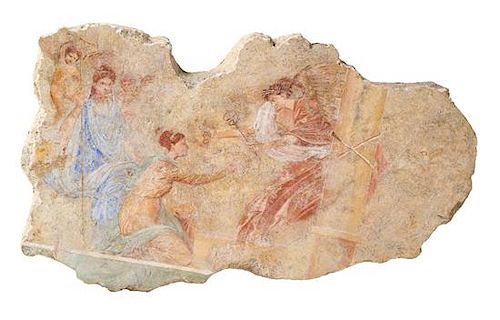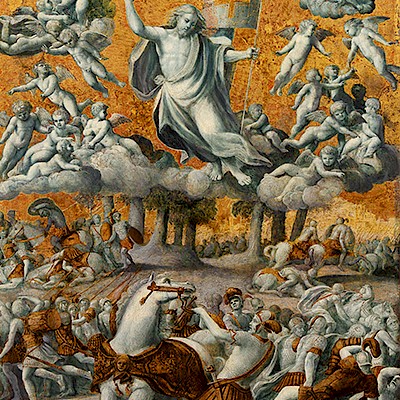* A Roman Wall Painting Fragment Length 23 inches.
Lot 21
About Seller
Hindman
1338 West Lake Street
Chicago, IL 60607
United States
Recognized as the Midwest's leading fine art auctioneers, Hindman Auctioneers has built a worldwide reputation based on a full service approach to the auction business tailored to meet the individual needs of our clients. Coming from a variety of educational backgrounds, specialists bring years of e...Read more
Estimate:
$30,000 - $50,000
Absentee vs Live bid
Two ways to bid:
- Leave a max absentee bid and the platform will bid on your behalf up to your maximum bid during the live auction.
- Bid live during the auction and your bids will be submitted real-time to the auctioneer.
Bid Increments
| Price | Bid Increment |
|---|---|
| $0 | $25 |
| $500 | $50 |
| $1,000 | $100 |
| $2,000 | $250 |
| $5,000 | $500 |
| $10,000 | $1,000 |
| $20,000 | $2,500 |
| $50,000 | $5,000 |
| $100,000 | $10,000 |
About Auction
By Hindman
Oct 30, 2018
Set Reminder
2018-10-30 11:00:00
2018-10-30 11:00:00
America/New_York
Bidsquare
Bidsquare : Worldly Pursuits: The Estate of Steve & Peggy Fossett
https://www.bidsquare.com/auctions/hindman-auctions/worldly-pursuits-the-estate-of-steve-peggy-fossett-3506
Hindman Bidsquare@hindmanauctions.com
Hindman Bidsquare@hindmanauctions.com
- Lot Description
* A Roman Wall Painting Fragment
circa 1st century b.c.e.-1st century c.e.
painted in vibrant, bright pigment, preserving a five-figure composition within an architectural setting, the goddess Nike alighting from the right toward an orant kneeling before her, the goddess with her wings outstretched, wearing a rich red voluminous garment with deep folds, a white sash billowing over her right shoulder, a wreath of laurel in her hair, a caduceus held forth in her left hand, proffering a wreath toward the supplicant before her who reaches up toward Nike with her right hand, clad in a yellow long-sleeved belted chiton with a green himation wrapped around her neck and legs, her curly hair bound in a band and arranged in a chignon, further to the left the goddess Venus seated regally wearing a pale blue himation over a deep blue peplos, a long staff in her right hand, bejeweled with armlets and a gold diadem in her long tresses, two nude winged Cupids frolicking behind, a column in the right foreground, a bird further to the right, the white groundline with a block of green below.
Length 23 inches.
Estimate $30,000-50,000
Provenence:
Acquired from the Merrin Gallery, New York, August 31, 1989
Note:
The fresco technique, developed in antiquity, was a durable wall-painting enhancement process that was comprised of the application of rich pigments onto still-wet lime plaster. In the Roman period the method was employed to adorn the homes of the wealthiest and most elite echelons of society. Still preserved in quantity in the cities preserved by the eruption of Vesuvius in the environs of the Bay of Naples in 79 C.E., Roman domestic frescoes can also be found sprinkled throughout the boundaries of the Roman Empire.
Art historians have categorized Roman wall painting into four distinct styles, with varying degrees of figural and architectural detailing, each developing seamlessly from the other. Without further indication of the decorative scheme surrounding the present scene, it cannot be categorically placed in this definitive framework. However, the architectural elements do reveal similarities to the so-called Second Pompeiian Style, popular throughout the 1st century B.C.E.
The bold colors of Roman frescoes indeed contrast with the stark white of preserved ancient marble sculpture. Sculptures would also have originally been brightly painted. Therefore, ancient wall paintings are one of the most illustrative examples of the bold tints that enriched ancient material culture.
It has been suggested that the composition on this fresco prefigures the iconography of the Christian Annunciation.
Repaired from several fragments with minor fill in the breaks and in the losses. Surface wear, pigment loss, minor chips and cracks throughout. The edges rough. - Shipping Info
-
Please refer to https://www.lesliehindman.com/shipping-packing/
-
- Buyer's Premium



 EUR
EUR CAD
CAD AUD
AUD GBP
GBP MXN
MXN HKD
HKD CNY
CNY MYR
MYR SEK
SEK SGD
SGD CHF
CHF THB
THB











